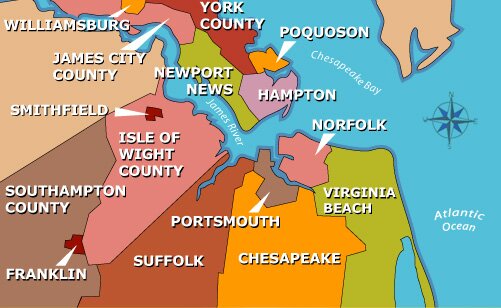Home > Hampton Roads Community Info
- Select a city or county
for more information - Chesapeake
- Hampton
- Isle of Wight County
- James City County
- Newport News
- Norfolk
- Portsmouth
- Southampton County
- Suffolk
- Virginia Beach
- Williamsburg
- York County
The Communities of Hampton Roads
Click on the map for information about a specific community

Hampton Roads is the name for the southeastern region of Virginia. The region's most notable geographic characteristic is proximity to a variety of waterways. Bordered on the east by the Atlantic Ocean, Hampton Roads is where the James, Nansemond and Elizabeth rivers pour into the mouth of the Chesapeake Bay. "Hampton Roads" is a nautical term meaning "protected anchorage"or "a safe harbor." With the world's largest natural harbor, Hampton Roads' ports have played an important role in the region's history and economy.
Hampton Roads is home to 1.6 million people and is the birthplace of Colonial America. It is home to Jamestown, the first permanent English settlement and to Colonial Williamsburg. Its rich history, thriving maritime industry and beautiful waterfront landscapes merge with livable communities, modern technology, economic prosperity, and a strong military presence to create a unique and welcoming place in which to live, do business and raise a family.
The military has been a mainstay of the Hampton Roads economy which enjoys the largest combined concentration of Navy, Army, Air Force, Marine and Coast Guard personnel in the nation, with forces stationed at facilities such as Naval Station Norfolk, Langley Air Force Base in Hampton, Oceana Naval Air Station in Virginia Beach, Little Creek Amphibious Base, Norfolk Naval Shipyard, Fort Eustis in Newport News, Fort Monroe, Fort Story, Joint Forces Command's Joint Warfighting Center in Suffolk, U.S. Coast Guard 5th Atlantic Fleet HQ, Naval Medical Center Portsmouth and Yorktown Weapons Station.
Hampton Roads is rich in intellectual resources. The region is home to eight universities and 4 community colleges attended by over 89,000 students. In addition, the region boasts two federal laboratories: The Thomas Jefferson National Accelerator Facility, a U.S. Department of Energy facility that conducts basic and applied atomic research and the National Aeronautics and Space Administration's (NASA) Langley Research Center, an 800-acre facility conducting research in aviation and space sciences.
As one of the most successful commercial shipping ports in the United States, the Port of Hampton Roads links Virginia and the mid-Atlantic to more than 250 ports in over 100 countries. With its four marine terminals, the Port of Hampton Roads is the second largest volume port on the East Coast in terms of general cargo and the leading U.S. port in total tonnage.
Located well within a 30 minute commute of most business and residential areas in the region, Norfolk International (ORF) and Newport News/Williamsburg International (PHF) Airports provide air service to over 4 million passengers annually. Nine major airlines and six regional commuter airlines provide over 260 flights per day to 25 airports of which 17 are major hubs and international gateways.
A pre-eminent maritime center, the region is thoroughly entwined and proudly identified with the water which includes over 26 miles of Atlantic Ocean beaches, the Chesapeake Bay, and a host of picturesque rivers and inlets. Hampton Roads is blessed with environmental assets as well, including First Landing State Park, False Cape State Park, the Great Dismal Swamp National Wildlife Refuge and Back Bay National Wildlife Refuge, to name a few.
Hampton Roads is rich too with cultural treasures reflecting the artistic diversity of its communities. Throughout the year, festivals celebrate the cultural heritage of the region. History, music, drama and art treasures can be found in the theaters and museums of Hampton Roads.




